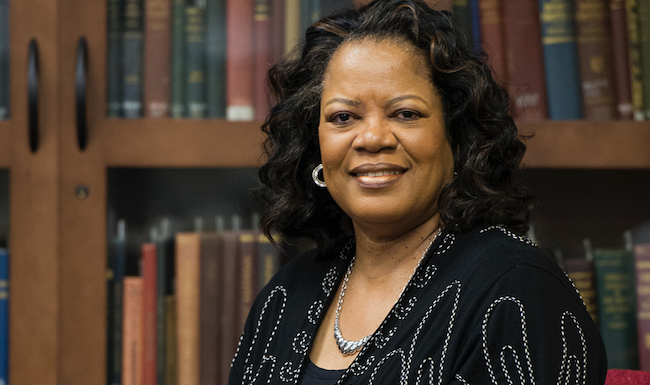Progress notes

Dr. Lavern Holyfield didn’t choose her path to dental education. Rather, it chose her.
“As much as I enjoy practicing, I realized early in my career that I wanted to teach. I stayed in practice because I could not justify doing anything else after all the work, and because I did not want to let my family and friends down,” says Holyfield, who enrolled at the dental school 43 years ago. That was a milestone year, as Holyfield and Dr. Jerry Lewis Mathis were the first African-American students the school had accepted in its classes up until that point in its almost 70-year history.
“I understood the significance of this milestone,” recalls Holyfield, director of faculty development. “From there, my passion grew.”
She graduated in 1977, taught part time for several years in the mid-1980s and returned in 1998, receiving a full-time faculty appointment soon thereafter. She volunteered on what was then the Welcoming Diversity Committee and joined the ranks of faculty colleagues such as Dr. Marvin Hirsh, a visionary she describes as “passionate about respect and fair treatment for all.” The committee provided diversity workshops for students, and as demand for this training grew, Holyfield even traveled to other dental schools like the University of Mississippi School of Dentistry to present the material.
With time, the American Dental Association’s Commission on Dental Accreditation recognized the need for such cultural competence training, and Holyfield was primed to take the lead on such matters at Texas A&M College of Dentistry. For years, cultural sensitivity training has been the norm for students, and now, Holyfield is overseeing its expansion to faculty and staff.
“It became my personal mission to help make the College of Dentistry a more accepting and inclusive environment,” says Holyfield, who is busy these days implementing IDEA — the college’s Committee on Inclusion, Diversity, Equity and Access.
Outside of the dental school, nearly 30 years of involvement with the South Dallas Business & Professional Women’s Club has led to initiatives that foster diversity and inclusion, but in slightly different arenas. A program geared toward building positive relationships between citizens and law enforcement and a program that celebrates the accomplishments of a number of Dallas-area women have gained attention. On Nov. 14, the Dallas City Council will recognize these initiatives and honor the group for its six decades of service to the Dallas-Fort Worth Metroplex. As the organization’s national first vice president, Holyfield, along with several of the group’s members, will be front and center at City Hall.
What legacy do you aspire to leave at the dental school?
Being the first African-American female to matriculate at what was then Baylor College of Dentistry and returning as faculty and director of diversity and faculty development, I’ve come full circle. I want it known that if I had to do this all over again, I would. I’d choose this college and every one of my classmates and instructors; for each of them helped to shape my experiences as a dental professional and my love for the profession. I truly enjoy being here, and it is my goal to help make sure that all faculty, staff, students and patients feel welcome and respected. I want to assure that there is a plan of action that promotes inclusive excellence at the college, in perpetuity.
What is most rewarding about your role in faculty development?
The new faculty orientation seminars and the Faculty Mentoring and Career Development Program allow me to help faculty members learn the resources that are available to them, understand what is expected of them. It is rewarding to know that I play a role in guiding them along their paths as academicians.
What are the college’s next steps in the areas of diversity and inclusion?
The College of Dentistry Diversity and Inclusion Plan has been written, vetted by the IDEA Committee and approved by the Administrative Council. The plan calls for expanded efforts to make the college a more diverse and inclusive campus. An example is cultural competence training. Training in this area has been provided for students on an ongoing basis for many years; however, only limited training experiences have been available to faculty and staff. Now, a long-term goal of providing routine training for faculty and staff will be realized. Within the next several weeks, all employees will be required to access and complete a TrainTraq module on the subject.